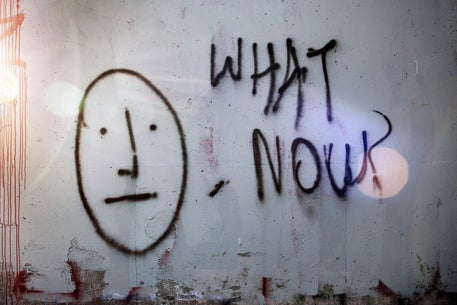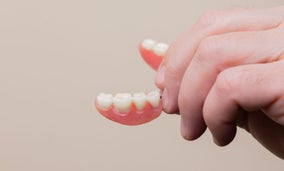Key words: OSA, CPAP, BPAP, full face mask, mask leak, dryness, teeth, dentures
The intended audience for this post includes healthcare team members interested in improving their patients' experiences with CPAP therapy. This post may also be relevant for some CPAP users.
This content is not medical advice.
In the world of obstructive sleep apnea (OSA) management, the state of a person’s smile can open up a world of treatment possibilities. When there are no teeth, the options become limited.

Photo credit Kev Bation on Unsplash
The Case
Mr C’s CPAP journey has not been the easiest. He has been through several masks and none of them are right. On the night of his sleep study, he found out the hard way that he needs a mask with nose and mouth coverage (full face mask). Since then, he has tried multiple full face masks of various sizes. They all seem to have the same issues with leak, noise, dryness, and sleep disturbance.
Like others struggling with mask fit issues, Mr C thought having the mask tighter would make it seal better. He finds the tighter he cranks it, the more likely it is to end up in his mouth and hurt his face. The worst part is that this doesn’t help with the leaking, noise, and dryness.
Mr C contemplates giving up, but before he does, he wants to know if you, as part of his healthcare team, have any advice that might be helpful.

Photo credit: Tim Mossholder on Unsplash
What Mr C is dealing with should not be happening.
CPAP masks are designed to float on the face. They need enough headgear slack to inflate when pressure is applied. In doing so, the cushion seals to the face, optimizing pressure delivery to keep the airway open.
Where mask seal is poor, pressure delivery is compromised leading to leak, noise, dryness, and frustration. If the patient isn’t frustrated by this, their bed partner is likely to be.
While there are numerous potential root causes for Mr C’s CPAP mask issues, the historical key is his report of the mask ending up in his mouth along with the leak issues.
The mask-in-mouth problem

Photo credit: Zahra Amiri
Notice how the lower lip leans backward.
Due to lack of lower front teeth, this gentleman is at risk for experiencing mask-in-mouth if he were to try a full face mask without something to support the inferior edge of the mask cushion.
The mask-in-mouth problem occurs when the lower dental ridge is too shallow for the CPAP mask to rest on effectively. Without some underlying structure to hold up the face just above the chin (like teeth or dentures), a full face mask is going to end up in a person’s mouth consistently. And this is where we find Mr C.
When he initially tried on all those CPAP masks, it is likely Mr C would have worn his dentures. At bedtime, his teeth live in a cup on the bathroom counter. With nothing for the bottom of the mask to securely rest on and seal with during sleep, the flapping between mask, lips, and cheeks begins.
He tightens the headgear and tries to sleep. As his pressure ramps up, the problem worsens.
When he can sleep, he wakes up with terrible dry mouth. His humidifier has run out of water and getting up for the day remains hours away. Maybe the AHI on his machine looks OK. Maybe it doesn’t. The leak from his download is likely sky high.
Do your teeth come out at night?
Whenever I come across a patient having difficulties like Mr C, I have learned to ask about their smile. Do they have all their teeth, or do they have dentures? Do their teeth come out at night? Has the person tried wearing their teeth with their mask? If so, was it helpful?
A patient could try on every full face mask on the market, but without lower teeth of some sort in place, the chances of any of those masks fitting well is slim to none.
Lack of teeth messing with CPAP is easy to overlook in the frenzy of all the other things that go into getting good mask fit and CPAP success. Once it is identified as a potential treatment barrier, getting it addressed can make a world of difference for the patient and their CPAP journey.
Key points:
- Identify your patient’s dental status with regard to lower teeth.
- If no lower teeth with sleep in the setting of CPAP difficulties, sleeping with teeth in may provide the needed facial structure for the mask to seal.

Photo credit: Diana Polekhina on Unsplash
Wait for it…
In case you’re thinking having your patient sleep with their teeth in is going to be a magic fix, guess again.
Mr C tried sleeping with his teeth in place, but he couldn’t pull it off. After a few hours with his lower teeth in, his lower lip became tender and painful. He decided to return his teeth to the cup on the bathroom counter and call it a night.
What I would tell my younger self
When I first started working with patients suffering from mask leak due to lack of teeth, I only had the toothless part of the problem figured out. Support the face. The mask should fit. Right?
If only it were that easy.
Here's what I would have told myself when I was just starting out with CPAP management in Sleep Medicine:
- Beware of pre-existing mask overtightening. Patients will need to back off on their headgear when they first try their mask with teeth in. Skip this step and you can expect lip tenderness to be prohibitive.
- Changing from a full face mask to a nasal mask or nasal pillows, may be a viable alternative solution for selected patients. The smaller the mask, the less contact it needs to have with the face to get a good seal. Nose-only mask options can usually be worn without regard to dental status, though they require the patient to sleep and breathe with mouth closed.
- Treatment of OSA is the only medical reason I am aware of for a patient to sleep with teeth in. The general recommendation on dentures is to rest the mouth at least 4 hours per day. When OSA treatment is not a concern, having patients sleep with teeth out makes sense because most people sleep longer than 4 hours per night.
- Even with all our best efforts to promote CPAP success, sometimes we can't get the mask to seal no matter what we try. When that happens (because it will happen), the challenge is to decide with the patient whether the risks of CPAP with a full face mask are worth the reward and to explore alternative options to address their obstructive sleep apnea.
Conclusion
Poor mask fit is one of the top contributors to CPAP failure. Lack of facial structure can be a full face mask deal breaker. Identifying lack of dentition during sleep may improve mask seal and patient experience. Patients will need to loosen and re-snug their headgear when a "teeth-in" trial is initiated. They will also need to decide on alternative time to have their teeth out for mouth rest and hygiene routines.
I want The Sleep NP to write about _______________ in future blog posts.
For more information and resources on sleep apnea management, sign up for my email list on my website, www.TheSleepNP.com, or send an email to info@thesleepnp.com.
To get periodic content updates, follow The Sleep NP on social media: Facebook, YouTube, and LinkedIn. When you like, follow, and subscribe, you’ll get updates as I post them.
If you like what you’re seeing from the Sleep NP, please share it. There are so many people suffering with sleep apnea and struggling with their CPAP therapy. While this content is not formal medical advice (and does not replace a patient’s healthcare team), you’ll be assisting me with my goal of helping more people sleep better so they can feel better and do better.
Thank you in advance.
Add comment
Comments
Hello Carrissa, this looks great! Very well done, professional and informative. Plus I learned a new word, "dentition". :)